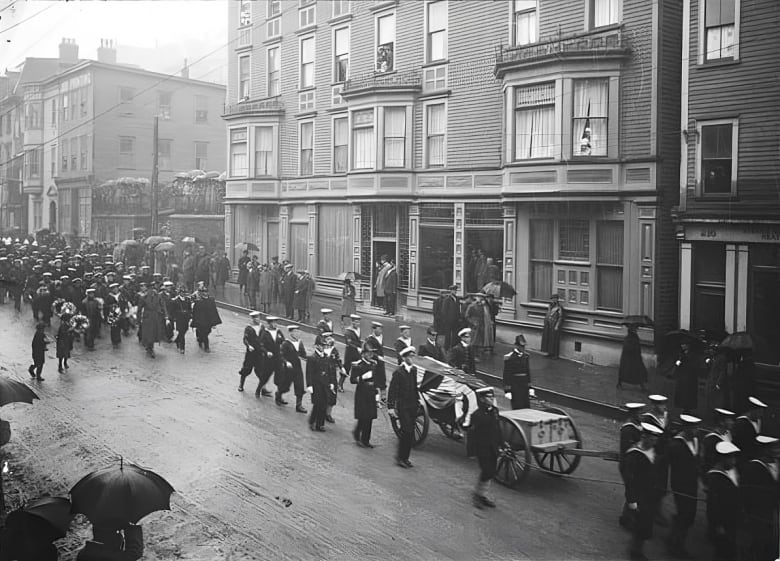The dying tradition of the funeral cortege
Is there still a place in our increasingly fast-paced world for solemn, intimate customs like this one?

It's a tale of two funerals.
Spring 2018, Corner Brook, N.L.: As we leave my grandmother's funeral, other drivers yield to our procession, even stopping on a green light to let us through so we aren't separated. We reach the cemetery together to bear the casket into a receiving chapel for a final farewell.
Spring 2023, St. John's: Leaving my cousins' grandmother's funeral, the hearse is immediately cut off from mourners by a courier van barrelling down the quiet side street. Despite our blinking emergency lights, the procession is interrupted by car after car, and we ultimately arrive at the cemetery by ones and twos, as though we had travelled separately.
The funeral cortege is a dying tradition, especially in larger centres where traffic is heavier and there's a higher proportion of young drivers unfamiliar with the tradition of yielding to them.
Critics say we'd be better off without processions, which delay transit and occasionally even lead to accidents. Is there still a place for solemn, intimate customs like this one in our increasingly fast-paced and impersonal society?
Funeral processions have existed throughout recorded history. They emerged independently in many different parts of the world, for purely practical reasons.

When a person dies, their remains must be transported from the location of their death to a place where their body can be prepared, then onward to their final resting place. Sometimes there's a stop at a ceremonial space like a church or a temple along the way.
Since death is a social event — one that engages family, friends and community in commemorating the loss — it's natural that the people who gather to honour the deceased should also accompany the corpse on its last journey.
A 4,000-year-old lament from Mesopotamia describes a king's funeral. Weeping soldiers escorted his body to its grave, where his donkeys and chariot were buried with him to carry him the rest of the way to the netherworld.
Upper-class Egyptian funeral corteges included family members, priests, servants and sometimes musicians or professional mourners. The Tale of Sinuhe (ca. 1900-1700 BC) vividly depicts the trip to the tomb from the corpse's perspective (translation by Roland Enmarch):
"A funeral procession will be made for you on the day of joining the earth with a mummy case of gold, a mask of lapis lazuli, a heaven over you, and you placed in a hearse, with oxen dragging you, and singers before you."
An ordinary person might not have a golden casket, but in most places they would have the dignity of some sort of procession. Their body might be carried on the shoulders of loved ones or pulled to the gravesite on a wheeled bier followed by neighbours and friends on foot.

In rural communities, the distance from the deceased's home to a cremation site or burial ground was usually short, but larger centres often required cemeteries to be located outside city limits for sanitary reasons or to preserve space for housing, making them difficult to reach on foot.
As a result, motor vehicles were incorporated into funeral processions almost as soon as they became widely available.
In 1908, the first car affordable to the middle class, the Ford Model T, was brought to market in the United States, and the first gas-powered "auto hearses" were introduced just a year later.
As car ownership became more and more common over the course of the 20th century, vehicular processions became the norm for funerals in many parts of the world, giving rise to new etiquette.
Participants in the cortege would drive slowly to mimic the sombre pace of a funeral march, and other drivers would usually give them the right of way.
These courtesies, however, weren't always enshrined in law.

Most provinces and territories allow cars in corteges to travel closer together than other vehicles, but only five — Nova Scotia, Prince Edward Island, Saskatchewan, Alberta and the Yukon — actually prohibit other drivers from cutting in.
As for running red lights and stop signs, that's allowed only under certain circumstances in Manitoba, Saskatchewan, Alberta and the Yukon, while P.E.I. is the lone province with a law requiring other drivers to slow down when approaching a cortege.
While they may have little legal protection, funeral processions can have a big emotional impact.
I had never given much thought to funeral processions until I was in one and found it comforting to see other drivers slow down or stop. After all, when someone we love dies, doesn't it feel like the world should stop, if only for a moment?
Those brief gestures of respect not only communicate sympathy and mutual support, they acknowledge that the deceased was part of the fabric of the community. Drivers might not know who's in the casket but may nonetheless feel the gap they leave behind — the regular customer who no longer pops into their coffee shop, the neighbour who no longer pets their dog, the receptionist who no longer answers their call.
In a culture where we're more and more insulated from death, it's also an opportunity for drivers to reflect on their own mortality. It's a memento mori, a reminder that we and our loved ones will soon be making that final journey ourselves and that we should live our lives with the knowledge they will not last forever.
Diverse, urban societies are bound by few common rituals. The funeral procession cuts across cultural and religious lines and allows us to recognize our common humanity.
Isn't that worth a moment's pause?

